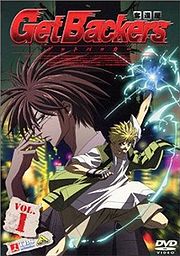
List of GetBackers episodes
Encyclopedia

Anime
is the Japanese abbreviated pronunciation of "animation". The definition sometimes changes depending on the context. In English-speaking countries, the term most commonly refers to Japanese animated cartoons....
series GetBackers
GetBackers
is a manga series written by Tadashi Agi and illustrated by Rando Ayamine. The series was serialized and is published by Kodansha's Weekly Shōnen Magazine from 1999 until 2007, totaling 39 volumes. The plot follows the "GetBackers", a group that retrieves anything that was lost...
were produced by Studio Deen
Studio DEEN
is a Japanese company that produces anime. Three years after Sunrise was founded in 1972, Studio Deen was established by Sunrise's members in 1975. As a result of this, anime shows such as Cowboy Bebop that were produced by Sunrise may have had assistance from Studio Deen.-Produced anime:* Urusei...
and based on the manga
Manga
Manga is the Japanese word for "comics" and consists of comics and print cartoons . In the West, the term "manga" has been appropriated to refer specifically to comics created in Japan, or by Japanese authors, in the Japanese language and conforming to the style developed in Japan in the late 19th...
series of the same name written by Yuya Aoki and illustrated by Rando Ayamine
Rando Ayamine
is a Japanese manga artist known illustrating the GetBackers series. Since the completion of Get Backers, he has been working on a new manga series called Holy Talker....
. The series premiered on Tokyo Broadcasting System
Tokyo Broadcasting System
, TBS Holdings, Inc. or TBSHD, is a stockholding company in Tokyo, Japan. It is a parent company of a television network named and radio network named ....
in Japan on October 5, 2002 and ran for forty-nine episodes until September 20, 2003 under direction of Kazuhiro Furuhashi and Keitaro Motonaga. The plot follows the "GetBackers", a group that retrieves anything that was lost. The team is primary composed by Ban Mido, a man born with the illusionary technique "Evil Eye
Evil eye
The evil eye is a look that is believed by many cultures to be able to cause injury or bad luck for the person at whom it is directed for reasons of envy or dislike...
", and Ginji Amano the former leader of a gang called "The VOLTS", a powerful group in the dangerous territory called the Infinity Fortress in Shinjuku.
The series was released to Region 2 DVD in Japan by TBS in seventeen individual volumes with three episodes per disc. The anime was first licensed in English by ADV Films. ADV released the English dubbed series in a total of ten Region 1 DVD volumes from August 24, 2004 to November 1, 2005. Compilations volumes from the seasons 1 and 2 were also released on October 10, 2006 and January 2, 2007, while a full compilation of the series was published on January 15, 2008. In April 2009, A.D. Vision started streaming the series online in their The Anime Network
Anime Network
The Anime Network , a former subsidiary of A.D. Vision, Inc. , is a cable and satellite digital broadcast service in North America dedicated to anime.-History:...
website. On September 1, 2009, all of ADV's catalog was transferred to AEsir Holdings, with distribution from Section23 Films
Section23 Films
Section23 Films is an American home video distribution company specializing in anime and Japanese films. The company is one of five successors to ADV Films, as well as the distributor of titles from Sentai Filmworks and Switchblade Films. ADV had announced that it had sold its assets to a group of...
.
The anime's music was composed by Taku Iwasaki, and two original soundtracks were released by Pioneer Corporation
Pioneer Corporation
is a multinational corporation that specializes in digital entertainment products, based in Kawasaki, Kanagawa, Japan. The company was founded in 1938 in Tokyo as a radio and speaker repair shop...
in Japan on January 24, 2003 and July 25, 2003. Six pieces of theme music
Theme music
Theme music is a piece that is often written specifically for a radio program, television program, video game or movie, and usually played during the title sequence and/or end credits...
are used for the episodes; two opening themes and four ending themes, while one opening theme was also used as an ending theme. The opening themes are by Naomi Tamura, used for the twenty-five episodes and by Pierrot
Pierrot (band)
Pierrot was a Japanese visual kei rock band, originally founded as Dizy-Lizy in 1994 by Kirito and Jun in Nagano. The original band members were Hidelow on vocals, Kirito and Jun on guitar, Kohta on bass and Luka on drums. After changing their name to Pierrot, Luka left in November and Takeo joined...
, used until the last episodes. The five ending themes are by Otoha
Otoha
Otoha is a feminine Japanese given name.Otoha can be written using different kanji characters and can mean:*乙羽, "maiden, feathers"*乙葉, "maiden, leaf"*音羽, "sound, feathers"*音葉, "sound, leaf"The name can also be written in hiragana or katakana....
for the first thirteen episodes, Bon Bon Blanco
Bon-Bon Blanco
Bon-Bon Blanco is a Japanese pop group during 2002~2009. The origin of the name is Spanish. The group used to belong to Columbia Music Entertainment, but has moved to Bouncy Records in 2006.-Members:Its members are:...
's , used for the next twelve episodes, "Mr. Déjà vu" by Naja, which is for episodes 26 to 37 and "Changin" by Nona Reeves, which is used from Episodes 38 until 48. "Yuragu Koto Nai Ai" Tamura, which is the first opening of the anime, is also used as the ending of episode 49.
Season one
| # | Title | | Original air date |
|---|
Season two
| # | Title | | Original air date |
|---|

